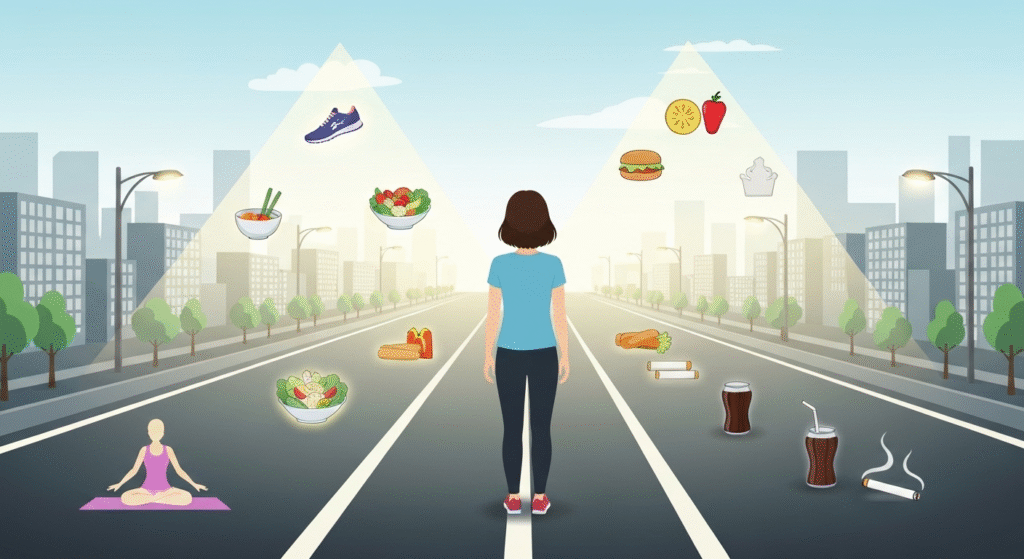
Key Highlights
Here’s a quick look at what you’ll discover in this guide:
- A plant-based diet is a powerful tool for preventing, managing, and even reversing type 2 diabetes.
- Eating more plant foods can improve insulin resistance, a key factor in the development of type 2 diabetes.
- Adopting new dietary patterns focused on plants can help you naturally lower your blood sugar.
- This eating style offers significant health benefits, including weight loss and improved heart health.
- You don’t need to count calories or carbs when focusing on a whole-food, plant-based diet.
-
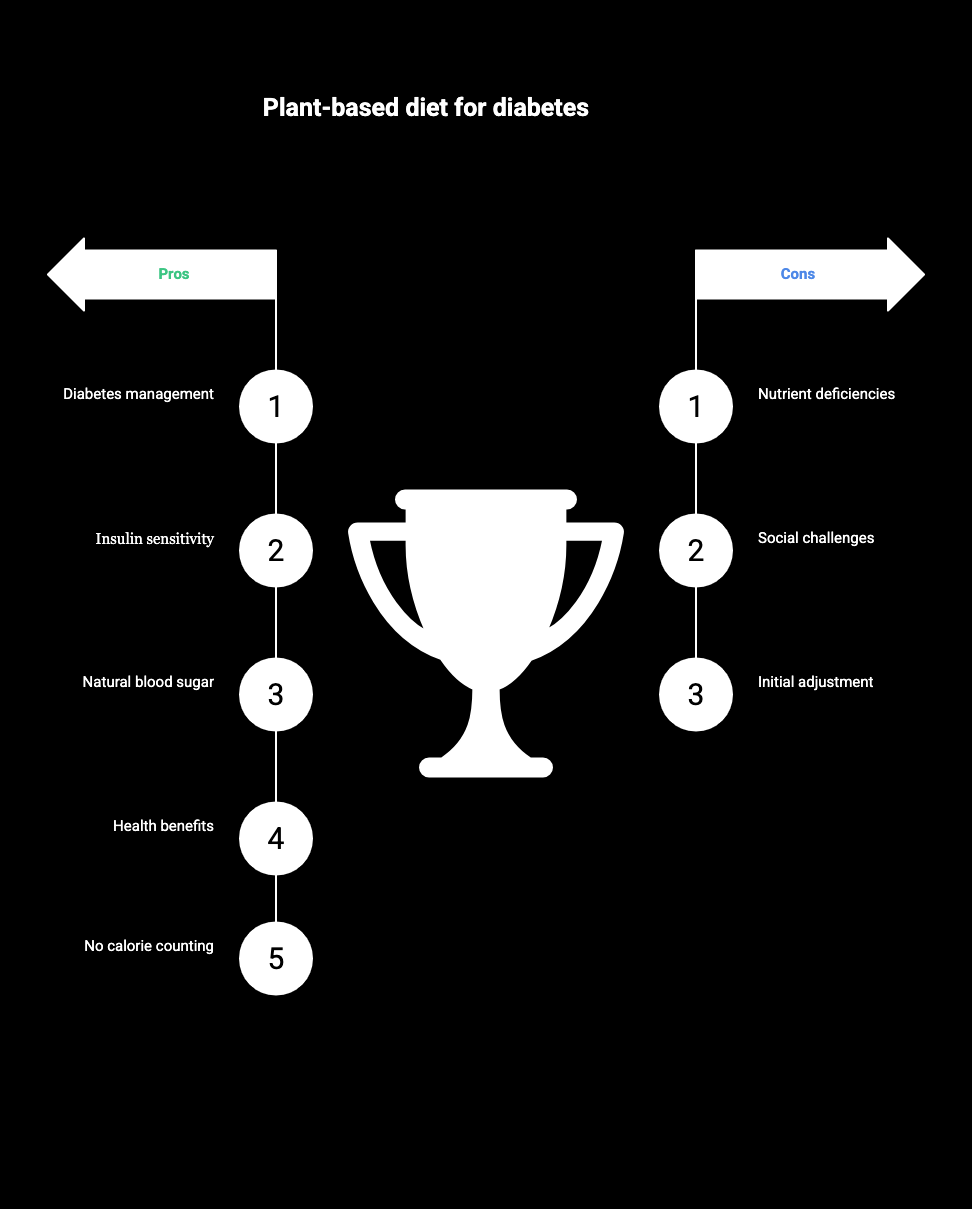
Introduction
If you’re living with type 2 diabetes, you know that managing your health is a top priority. You may have heard that changing your diet can make a huge difference, but where do you start? This guide explores how a plant-based diet can be a game-changer for diabetes management. We’ll walk you through the science, the benefits, and practical tips to help you embrace an eating style that can transform your health and help you regain control of your blood sugar.
Understanding Type 2 Diabetes and Plant-Based Eating
Understanding how your body works is the first step toward making effective dietary changes. Type 2 diabetes, a form of diabetes mellitus, is closely linked to your lifestyle and eating pattern, which is great news because it means you have the power to influence it.
This section will explore the basics of type 2 diabetes, including the roles of insulin secretion and resistance. We will also introduce plant-based diets and explain why this dietary approach is so effective for managing blood sugar.
What Is Type 2 Diabetes?
Type 2 diabetes is a condition where your body struggles to use energy from food efficiently. Normally, your pancreas releases a hormone called insulin, which helps move glucose (sugar) from your blood into your cells for energy. In type 2 diabetes, your cells stop responding normally to insulin, a problem known as insulin resistance.
To compensate, your pancreas works overtime to produce more insulin. Over time, it can’t keep up, leading to high blood glucose levels. This is why improving insulin sensitivity is a cornerstone of the treatment of diabetes. The good news is that lifestyle changes, especially in your diet, can have a profound impact.
Starting a plant-based diet is simpler than you might think. A great first step is to begin by cutting out processed meats and focusing on adding more high-fiber plant foods like fruits, vegetables, and whole grains to your meals. This simple dietary shift can be a powerful move toward better diabetes management.
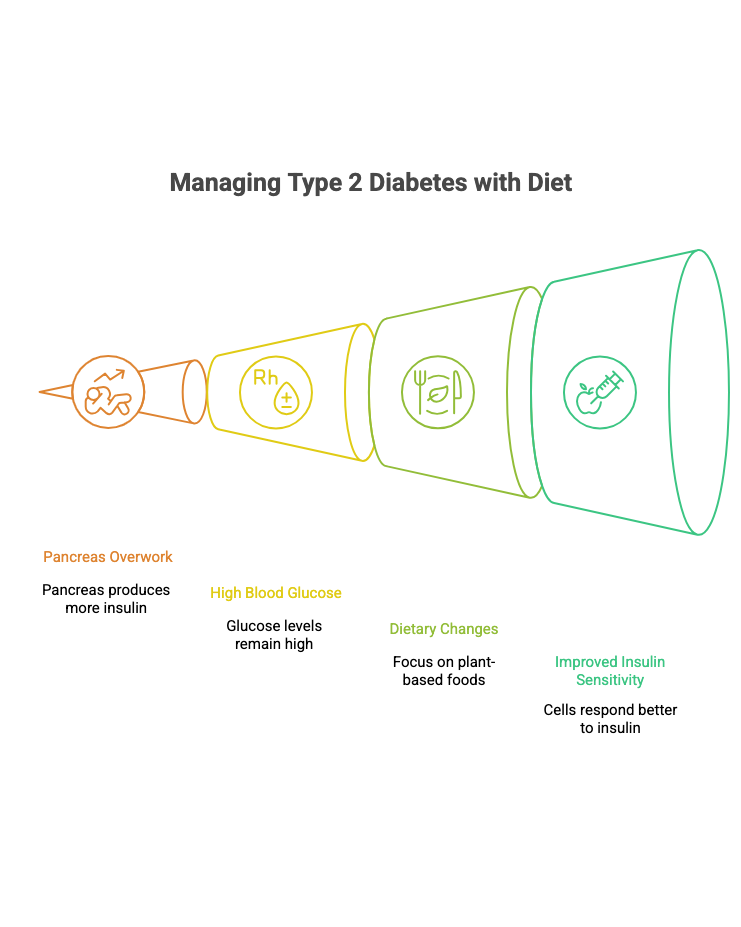
Title: Harnessing the Power of a Plant-Based Diet to Manage Type 2 Diabetes
Managing Type 2 Diabetes doesn’t have to be a daunting task. With a few changes in your dietary habits, particularly with the introduction of a plant-based diet, you can take significant strides towards controlling your blood sugar levels and achieving better health. Dr. Kulmeet Kundlas provides insightful tips to help you navigate this journey successfully.
The Plate Method for Balanced Meals
Imagine managing your Type 2 Diabetes by simply rearranging the components of your meals. A practical approach you can take is adopting the “plate method.” This method encourages filling half of your plate with non-starchy vegetables, a quarter with whole grains or beans, and the remaining quarter with plant-based proteins.
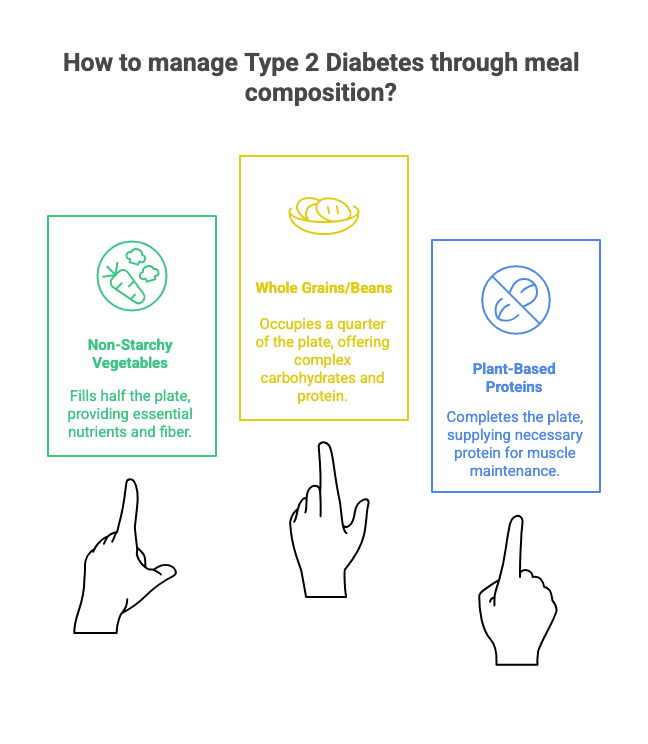
Non-Starchy Vegetables
Embrace vegetables like spinach and broccoli, which are low in carbohydrates but loaded with essential nutrients and fibers. They help maintain a full feeling, discouraging overeating, and aid in blood sugar management.
Whole Grains and Beans
Select options such as quinoa, brown rice, or lentils. These complex carbs have a low glycemic index, causing a slower and more gradual increase in blood sugar, making them an excellent choice for diabetics.
Plant-Based Proteins
Incorporate foods like tofu and lentils. These protein sources are beneficial for building and repairing tissues while also offering heart health benefits.
Benefits of the Plate Method
This straightforward and easily adoptable method not only assists in stabilizing your blood sugar levels, which is crucial for diabetes management, but also promotes weight loss and increases energy levels.
Whole Grains and Starches
Forget the myth that you have to avoid carbs. The key is choosing the right kind of carbohydrates. Whole grains are one of the best food groups for controlling blood sugar. Unlike refined grains, which are stripped of their nutrients, whole grains contain fiber that slows down the absorption of sugar into your bloodstream. This prevents sharp spikes in blood sugar.
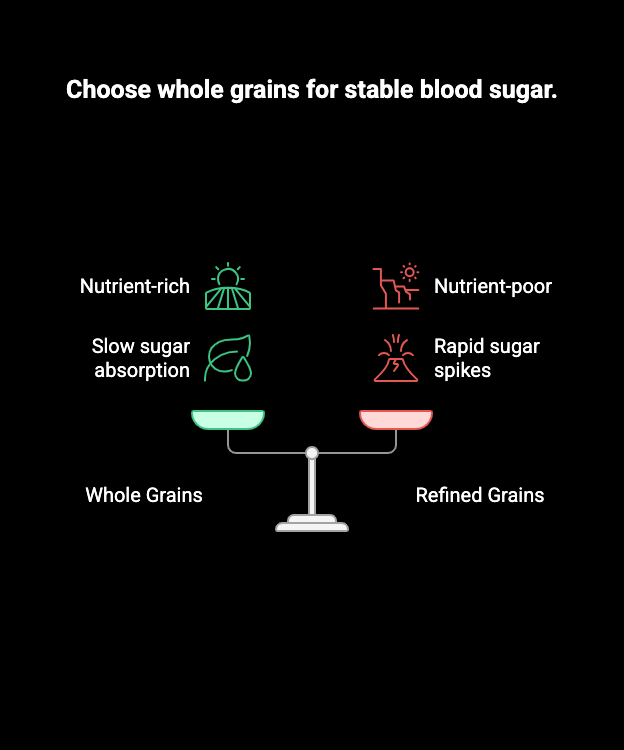
Foods like oats, quinoa, and brown rice have a low glycemic index (GI), meaning they cause a slower, more gradual rise in blood glucose. Research shows that people who eat more whole grains have a significantly lower risk of developing type 2 diabetes.
Incorporating these into your diet is easy. Start your day with oatmeal, make a quinoa salad for lunch, or serve brown rice with your favorite vegetable stir-fry.
|
Whole Grain Examples |
How to Enjoy Them |
|---|---|
|
Oats |
As oatmeal with fruit, or in homemade granola. |
|
Brown Rice |
A base for stir-fries, curries, or grain bowls. |
|
Quinoa |
In salads, soups, or as a side dish. |
|
Barley |
Added to hearty soups and stews. |
Overcoming Initial Struggles
Transitioning to a new way of eating is a significant lifestyle change, and it’s normal to face some struggles at the beginning. You might wonder what to cook, how to read labels, or how to handle cravings. The key is to be patient with yourself and build strong support systems.
Starting your dietary intervention can be as simple as changing one meal at a time. Maybe you start by having a plant-based breakfast every day. Or you could try “Meatless Mondays” and gradually expand from there. Small, consistent steps are often more sustainable than a drastic overnight overhaul.
To make the transition easier:
- Find delicious recipes: Explore blogs and cookbooks to discover meals you’re excited to eat.
- Join a community: Connect with others online or in person who are on a similar journey.
- Focus on what you can eat: Instead of thinking about what you’re giving up, celebrate the abundance of delicious plant foods you can enjoy.
Conclusion
Adopting a plant-based diet can be an empowering choice for managing Type 2 diabetes. By focusing on nutrient-dense foods and understanding how these choices impact your blood sugar levels, you can take control of your health. The benefits of this lifestyle extend beyond just blood sugar management; it offers improved heart health, weight management, and enhanced overall well-being. As you embark on this journey, remember to monitor essential nutrients and stay informed about meal planning strategies tailored for your needs. With the right approach and resources, you can achieve successful diabetes management while enjoying delicious, satisfying meals. If you’re ready to make the change, get a free consultation with our nutrition experts to create a personalized plan that works for you!
By focusing on a balanced, plant-based meal, you create a holistic approach to managing diabetes. It’s not only about what you eat, but how you arrange and balance your meals that can make a world of difference.
For more details and a comprehensive guide on managing Type 2 Diabetes through diet, click on the link in the description to watch the full video provided by Dr. Kulmeet Kundlas. Empower yourself with knowledge and take charge of your health journey. Thank you for reading.
Frequently Asked Questions
Can I follow a plant-based diet if I am taking diabetes medication?
Yes, but it’s crucial to work with your doctor. A plant-based diet can improve insulin sensitivity so effectively that your diabetes medication may need a downward adjustment. Your doctor can monitor your progress and safely adjust your dosage to prevent low blood sugar as your health improves with these dietary approaches.
How quickly could blood sugar levels improve after switching diets?
Improvements in blood sugar levels can happen very quickly. Some studies show significant enhancements in insulin resistance and blood sugar control in as little as seven days after starting a whole-food, plant-based dietary intervention. The health benefits can be both rapid and profound, sometimes leading toward diabetes remission.
Are there risks involved with a vegan diet for type 2 diabetes?
The main risks of a vegan diet for type 2 diabetes are potential nutrient deficiencies if it’s not well-planned. It is essential to ensure you get enough iron and calcium from plant sources and, most importantly, to take a reliable vitamin B12 supplement, as B12 is not found in plant foods.


